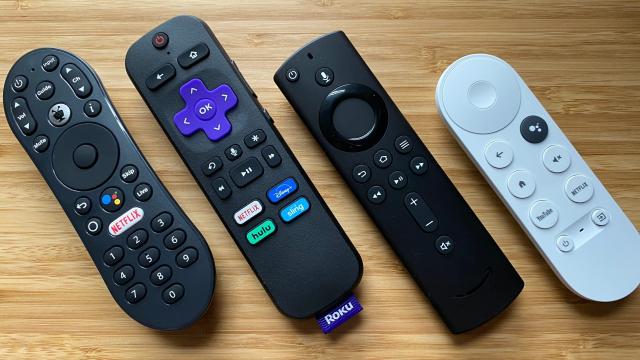Enough with the AAA batteries.
Gizmodo reviewed a lot of streaming gadgets this year, budget and premium devices alike. When staring at a heap of dongles, streaming sticks, and set-top boxes, one thing becomes immediately clear: Way too many dang remotes rely on batteries, and way too many of those batteries end up being tossed out and polluting the environment.
We’re talking most of the major streaming devices available right now. Roku, Fire TV, Chromecast with Google TV, Nvidia Shield TV, Tivo Stream 4K, and others all require a pair of batteries that will most likely eventually wind up in the trash. Apple TV’s remote is a rare outlier; it charges via a Lightning port.
I’m not giving Apple a free pass here on its dumb proprietary charging protocol. Device- or maker-specific charging cables are a huge pain in the butt, an environmental nightmare in their own right, and an avoidable problem that might be solved with a universal charging standard like USB-C. In my perfect world, the next-generation Apple TV would phase out its hell port in favour of something that plays nice with other charging cables and devices — though based on its recent product launches, I’m not holding my breath.
But Apple still has the best solution for reducing battery waste than most other major streamers. A single charge on my Apple TV remote can last months without me having to plug it in again, while some Roku users, for example, have reported that their remotes chew through batteries like wild. Of course, rechargeable batteries are an option here, but how many users are really going out of their way to equip their clickers with these to avoid waste? And most streaming devices I’ve unboxed ship with a standard pair of AAA batteries anyway.
Americans already throw out billions of batteries a year, according to the Environmental Protection Agency. Globally, a report earlier this year found the world trashed a record amount of e-waste, which batteries contribute to. Now, there are lots of ways to ensure fewer batteries end up in the trash, like improving recycling access.
But all I’m saying is that companies making grand (and disingenuous) climate pledges are also making it difficult from the consumer side to be mindful of waste. Is a rechargeable streaming remote with a universal charging port really too much to ask for? C’mon now.
Editor’s Note: This article was originally written for a U.S. audience, but we’ve done our best to update for Australian readers.
